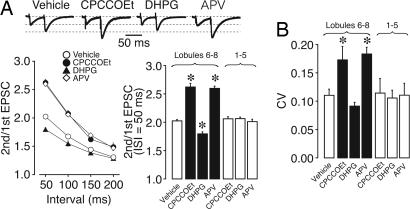Fig. 3.
Local mGluR- or NMDAR-mediated activity regulates release probability at PF synapses. (A) Paired-pulse plasticity of PF–EPSC in vehicle-, CPCCOEt-, DHPG-, or APV-treated PCs. (Upper) Representative EPSCs elicited by pairs of PF stimulations separated by 50 ms. The first EPSC is scaled to the amplitude of first EPSC in control. (Lower Left) PPRs recorded from PCs at lobules 6–8 were plotted as a function of the interval (n = 7 for vehicle, n = 5 for CPCCOEt, n = 6 for DHPG, and n = 7 for APV). The application of CPCCOEt or APV increases PPR, whereas that of DHPG decreases PPR. (Lower Right) Summary bars of PPR show that CPCCOEt, DHPG, and APV were effective in lobules 6–8 (closest to the implants), but not in lobules 3–4/5 (distant from the implants), showing the local effect of drugs from Elvax. These results suggest that presynaptic function at PF synapses correlates with NMDAR and mGluR activity. (B) Average CV of PF–EPSC amplitude in CPCCOEt-, DHPG-, or APV-treated PCs (n = 5–7). ∗, Differences were considered significant when P < 0.05.

